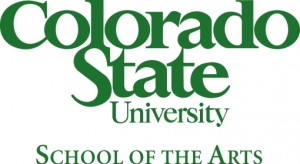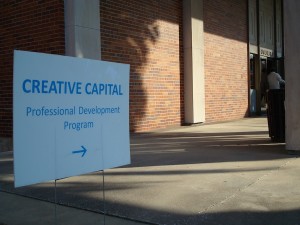
Arts Incubator of the Rockies moved into Fort Collins's renovated Carnegie Library in 2013
Is Arts Incubator of the Rockies Imperiled by Rent Default?
The future of Fort Collins’s national grant-winning arts organization Beet Street/Arts Incubator of the Rockies may be imperiled after the organization was recently in default on a year of rent to the City of Fort Collins.
Reached by telephone, Beet Street/AIR executive director Beth Flowers told AdobeAirstream that the mission for AIR is changing. With that change comes AIR’s removal from Beet Street’s management. Each organization now has its own board of directors. That process of excising AIR from Beet Street reportedly led to the rent default.
Beet Street which had “hosted” Arts Incubator of the Rockies (AIR) was mailed a letter dated May 4th from the city of Fort Collins stating that the organization was in default for a year’s back rent totaling $6,900, according to documents on the City of Fort Collins website. Ken Mannon, operational services director for the City of Fort Collins, said that the rent was paid on May 20th.
Fort Collins has positioned itself as the nexus of a Rocky Mountain arts economy, for which Beet Street/AIR was positioned to spur economic development.
Beet Street/AIR has been a recipient of Fort Collins funding for a number of years: a city memorandum dated January 23, 2014 states that the entity received $50,000 from the City in 2013 and another $60,000 in 2014 “to facilitate the management and development of a new targeted industry cluster within the community.”
“Despite the initial funding of AIR, the incubator continues to experience budget challenges and has requested $150,000 of additional financial support from the City,” the City memo says. But according to SeonAh Kendall, economic policy and project manager, AIR has not made an official request to Fort Collins for 2015.
These latest financial troubles for Beet Street and AIR follow on what seemed the brightest possible future for the putative Rocky Mountain arts incubator three years ago: In 2011, AIR received an $100,000 Our Town grant from the NEA, part of which funded the renovations of the historic downtown Carnegie Library space into which the organization moved in 2013. The organization agreed to provide in-kind staff support to the city to run the facility, while helping Fort Collins achieve strategic goals. It remains unclear which of the two organizations, now that they are splitting, will pay the rent after August 2014 on the Carnegie facility.
Moreover, now, contends Beth Flowers, Fort Collins is playing the politics by revealing recent funding requests that she said should have been stamped confidential.
How AIR Came To Be
Beet Street and AIR share a convoluted history.
Beet Street was founded in 2006 as a project of the Fort Collins Downtown Development Authority (DDA). The civic vision of Fort Collins was to create for itself a national reputation as an arts-and-cultural community and destination that would demonstrate “creative placemaking.”
The DDA committed $3 million over the years 2008-10 to Beet Street.
But Beet Street’s mission appeared to change as the economy failed. Pre-Recession, Beet Street had articulated a plan to do Chatauqua-style programming in a 4,000-seat amphitheater that would be constructed downtown.
In 2009, amidst the galloping Recession, the amphitheater project was a no go. According to Flowers, the thwarted amphitheater remains a political sore spot.
Next, Beet Street began organizing professional development programs, bringing Creative Capital to Colorado for the first series of professional artist development workshops ever offered in the state. In 2011, executive director Ryan Keiffer stepped down and Flowers moved into that position.
 Coalition-building in part for grant readiness, Beet Street began working with the City of Fort Collins’s Cultural Services department and Colorado State University’s LEAP (Leadership, Entrepreneurship, Arts Advocacy and the Public) program. Together, this public-private partnership applied for the Our Town grant. The proposal was to design and build AIR as a regional arts incubator created to serve a 10-state intermountain region. Figures from WESTAF estimate that more than 280,000 artists and creative individuals are found in the region with about a third, or 90,000 of them, residing in Colorado.
Coalition-building in part for grant readiness, Beet Street began working with the City of Fort Collins’s Cultural Services department and Colorado State University’s LEAP (Leadership, Entrepreneurship, Arts Advocacy and the Public) program. Together, this public-private partnership applied for the Our Town grant. The proposal was to design and build AIR as a regional arts incubator created to serve a 10-state intermountain region. Figures from WESTAF estimate that more than 280,000 artists and creative individuals are found in the region with about a third, or 90,000 of them, residing in Colorado.
Six state arts councils (Colorado, Wyoming, Idaho, Utah, Nevada and South Dakota ) pledged their support to AIR in November 2011 to provide fundraising assistance, marketing, networking and outreach. Wyoming and Nevada were both scheduled to host inaugural AIR Shift workshops in 2013, but both workshops later were canceled by those state councils.
Flowers said, “Therein lies the challenge of being a startup.”
To date only a handful of the estimated 1,200 members on the AIR website hail from other states than Colorado.
“One of the first things we realized in 2012 was that wow, this was a lot harder than we could have imagined and it’s no wonder that no one has figured this out,” Flowers said.
Curricula For Professional Development
In 2012, AIR focused on developing curriculum to provide professional development to artists and creative industries as well as an offering of website/software design.
During initial meetings with curriculum consultants and volunteers from the community to brainstorm what sort of professional development was needed, something happened — according to Flowers, a bunch of non-creatives showed up: small business owners, government officials and educators.
“We realized that what we were trying to do was different than providing business classes for artists,” Flowers said. “We wanted to change how art and culture was perceived and valued in the community.”
Flowers added that the curriculum was intended to foster understanding between business and artistic cultures rather than just catering to one economic sector. “We weren’t just designing curriculum that was about business planning skills, more importantly we wanted a curriculum that was about collaboration and really helping both sides of that equation to understand each other better. That shifted the curriculum itself and made it (AIR) a more challenging objective.”

The AIR curriculum is divided into three sections: AIR Shift, AIR Evolve and AIR Currents. AIR Shift is a weekend-long workshop that explores ways for art and business to connect through collaboration. Participants work together on a community challenge and propose creative solutions. AIR Evolve is a six-month business incubator program incorporating “design thinking” such as is modeled in a popular MOOC of Stanford University.
The organization went through three iterations of the Shift workshop, utilizing volunteer artists and creative professionals from Northern Colorado as guinea pigs. One of those participants, Nanci Erskine (who also participated in the Creative Capital Professional Development program) said the initial pilot workshops were “terribly unsuccessful.”
According to Flowers, “The curriculum design process changed everything that we started with in our original business plan.” She explained that now AIR Shift is morphing into an internship program linked to the curriculum of the CSU partner. At CSU, the AIR internship course is now required to earn a minor or a master’s degree in the LEAP program. Since the internship program launched, 14% of the students have been placed in paid positions with host agencies or businesses. “Which,” Flowers said, “is apparently a high number.” But what kind of jobs these are is unclear.
AIR has also been training individuals in several Colorado communities to offer the AIR curriculum. Some subsequently will be hired by colleges or universities as adjunct professors; others will work for collaborative arts organizations and governmental entities; and more rural locations will band together to fund bringing a trainer to the region.
The promised streaming, online curriculum remains a promise though one that has not yet delivered. What is clear is that AIR will not achieve its goal of offering a curriculum of more than 1,500 courses by 2014.
Ever the optimist, Flowers said: “The number of people who call every day is astonishing. A lot of people want this and want to participate in the process of building it together. To our detriment, our biggest challenge is that we are only two staff people and we haven’t been able to tell our story because there was work to get done.”
As AIR begins to split off from Beet Street, the future of planned economic training for Rocky Mountain region artists remains in question. Artist Erskine said, “As far as dispensing tangible things for artists, it’s not so much there.”
